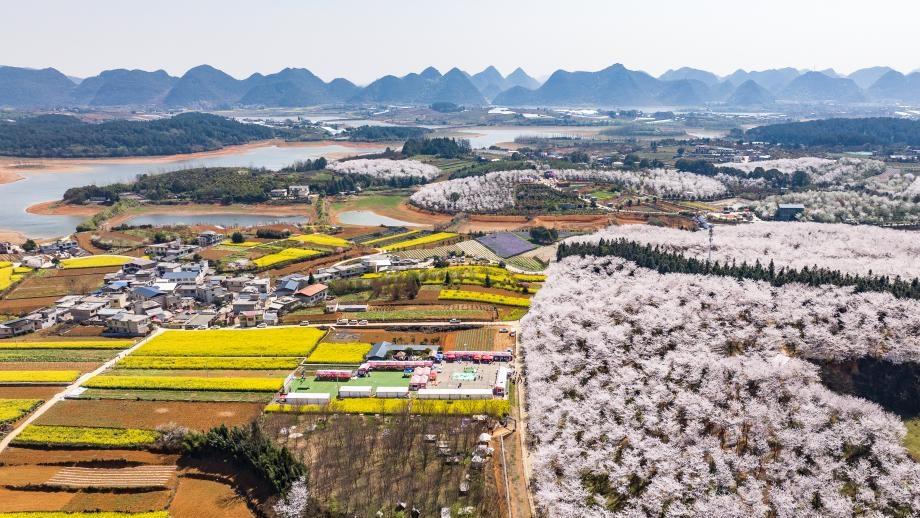Hydrogen energy industry thrives in Zhangjiagang in E China

Photo shows a hydrogen refueling station in Zhangjiagang, east China's Jiangsu province. (Photo provided by an interviewee)
In Zhangjiagang city, Jiangsu province, a region with a robust manufacturing foundation in eastern China, a comprehensive hydrogen industry ecosystem encompassing production, storage, transportation, and application is rapidly emerging and expanding.
The city routinely deploys hydrogen-powered tractors in port operations and hydrogen-fueled buses across urban road networks. Meanwhile, integrated hydrogen-solar smart microgrids have evolved into innovative "power bank" systems that deliver renewable energy solutions.
As a clean energy carrier, hydrogen demonstrates versatile applications in transportation and chemical industries, effectively reducing reliance on fossil fuels like gasoline, diesel and coal. When employed for large-scale, long-duration and seasonal energy storage, it further serves as a critical stabilizer for balancing power grid supply-demand dynamics.
In February, China's Ministry of Industry and Information Technology, along with seven other government bodies, jointly issued an action plan to promote high-quality development of the new energy storage sector, explicitly advocating accelerated research into ultra-long-duration hydrogen storage technologies.

Photo shows a hydrogen fuel cell workshop of an energy technology company in Zhangjiagang, east China's Jiangsu province. (Photo from the official account of Zhangjiagang's publicity department on WeChat)
Among hydrogen energy's most recognizable civilian applications is transportation. Capitalizing on its superior energy density, hydrogen proves particularly suitable for long-range mobility applications, with ongoing deployments spanning public transit systems, urban delivery networks, cold chain logistics, and heavy-duty freight transportation.
At the Jiahua hydrogen refueling station in Zhangjiagang Economic and Technological Development Zone, up to 1,000 kilograms of hydrogen are dispensed daily.
"The bus is equipped with eight hydrogen tanks totaling 26 kilograms of capacity. Refueling takes just 20 minutes," explained Chen Zhouhua, a bus driver refueling his King Long hydrogen-powered vehicle, produced by the prominent Chinese new energy automaker. After a full refuel, the bus can travel 400 kilometers, requiring Chen to replenish its hydrogen supply every one to two days.
Zhang Chengjian, general manager of a local public transport company, emphasized the environmental advantages: A single hydrogen-powered bus reduces annual carbon dioxide emissions by approximately 55 tons compared to a conventional diesel counterpart.
He noted that over the past six years, Zhangjiagang's hydrogen bus fleet has expanded to 73 vehicles. By the end of 2024, these buses had collectively logged 14.29 million kilometers, slashing carbon emissions by over 10,300 tons.
Beyond public transit, the city has integrated hydrogen technology across multiple sectors, deploying five hydrogen-powered port tractors, 65 hydrogen-fueled heavy-duty trucks, and more than 500 hydrogen-assisted bicycles. These innovations now operate seamlessly within port facilities, urban thoroughfares, and residential neighborhoods.
Under a newly released action plan (2025-2030) for advancing the high-quality development of Jiangsu province's hydrogen energy sector, the provincial government aims to establish a comprehensive clean, low-carbon, safe, and efficient hydrogen supply and utilization system by 2030. This initiative includes constructing over 100 hydrogen refueling stations and deploying more than 10,000 fuel cell vehicles across the province.
Multiple provincial-level administrations—including Shandong province, Sichuan province, Inner Mongolia autonomous region, Jilin province, and Henan province have implemented progressive policy incentives since 2020 to accelerate hydrogen vehicle adoption. Measures such as highway toll exemptions and the removal of road access limitations are effectively reducing hydrogen application costs while expediting pilot initiatives for hydrogen-powered transportation.
As the foundational stage of the hydrogen value chain, production methodologies currently prioritize by-product hydrogen derived from fossil fuel processes. However, renewable-energy-generated "green hydrogen" has emerged as the strategic focus for industrial advancement.
China's operational renewable hydrogen production capacity surpassed 100,000 metric tons annually by June 2024, with an additional 8 million tons per year in planned or under-construction projects. This exponential growth trajectory underscores the nation's substantial potential for scaling renewable hydrogen infrastructure.
The midstream sector encompasses critical storage and transportation technologies, including high-pressure gaseous containment, cryogenic liquid hydrogen systems, and dedicated pipeline networks. Downstream energy conversion is primarily achieved through fuel cell technologies and hydrogen combustion engines.

Photo shows a distributed photovoltaic grid-connected system and green hydrogen production R&D testing platform at the third-phase facility of Jiangsu Guofu Hydrogen Energy Equipment Co., Ltd. in Zhangjiagang, east China's Jiangsu province. (Photo from the official account of Zhangjiagang's publicity department on WeChat)
China has achieved mastery of core technologies spanning hydrogen production, storage, refueling, and fuel cell systems, with an annual hydrogen production capacity exceeding 40 million metric tons and over 500 operational hydrogen refueling stations nationwide.
Zhangjiagang serves as a prime example of this advancement. Hosting more than 40 hydrogen-related enterprises, the city has established an integrated ecosystem encompassing the entire industrial chain—from hydrogen production to end-use applications. Key players include chemical companies capable of supplying 200,000 tons of industrial by-product hydrogen annually, special equipment manufacturers dedicated to hydrogen infrastructure, and fuel cell enterprises driving innovation across upstream and downstream sectors.
According to Zheng Yuan, director of the Zhangjiagang major projects promotion center, the city's robust manufacturing foundation—particularly its expertise in high-pressure vessel production—provides a strategic advantage for hydrogen equipment development. Furthermore, its cluster of leading lithium-ion battery manufacturers supplies critical components essential to hydrogen fuel cell systems, bolstering the industry's expansion.
Leveraging these advantages, Zhangjiagang is actively reinforcing and extending its hydrogen energy industrial chain through targeted enhancements. This effort has propelled the city's annual hydrogen-related output beyond 10 billion yuan ($1.37 billion), solidifying its position as a hub for hydrogen innovation.
Photos
Related Stories
- Construction of China's High Energy Photon Source enters final stage
- China building more pumped-storage power stations to meet rising demand
- An up-close look at how China's earliest nuclear power plant cluster grows from follower to leader, offers solutions for global green energy transition
- Largest hydrogen fuel cell supply center in south China begins operation
- Ningxia sharpens its edge in new energy
- Key system of China's next-generation "artificial sun" passes acceptance process
- China's installed power generation capacity to exceed 3.6 billion kilowatts in 2025
- China to add over 200m kilowatts of new-energy power generation capacity in 2025 amid green transition
- China sees surge in green electricity certificate issuance in January
- World's first energy grass database created for sustainable development
Copyright © 2025 People's Daily Online. All Rights Reserved.









